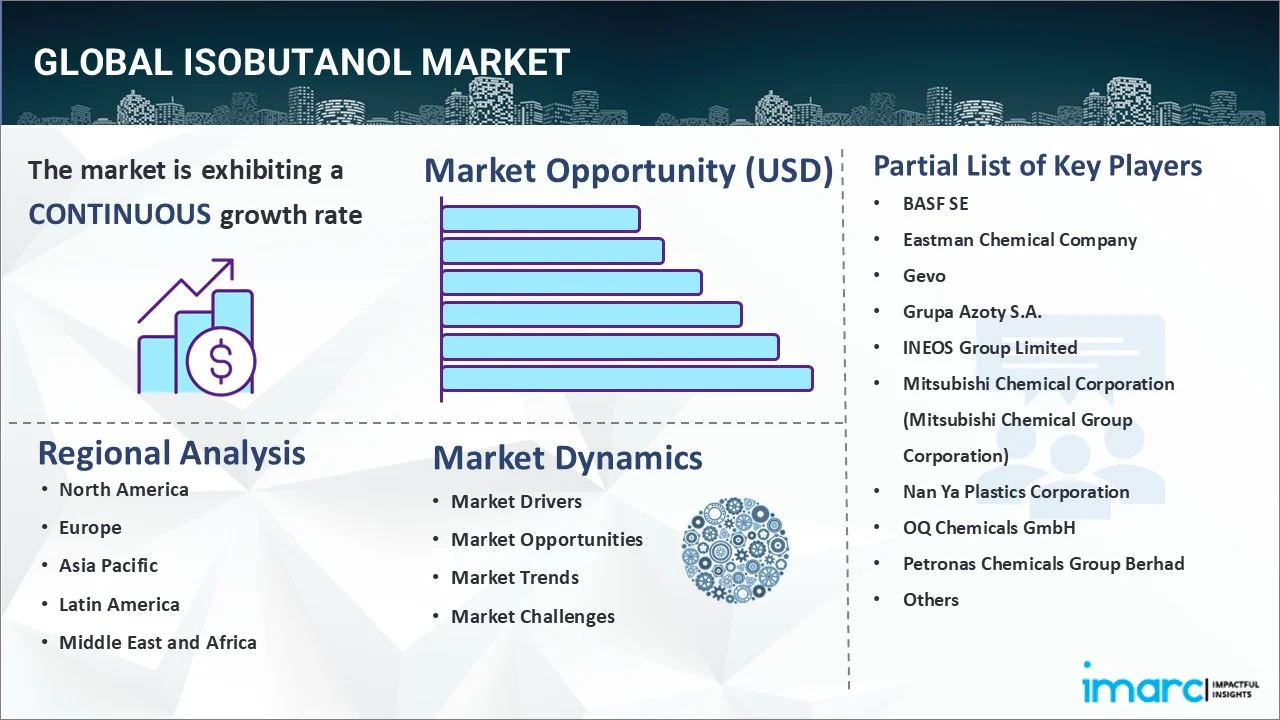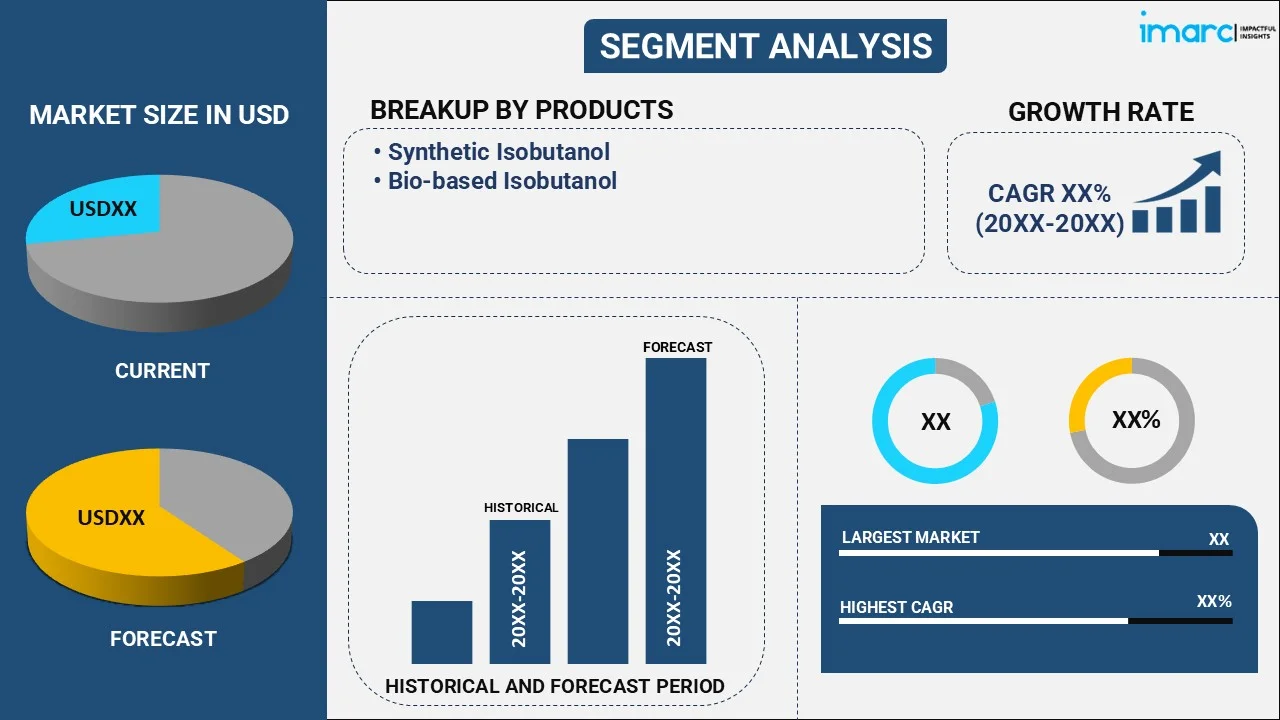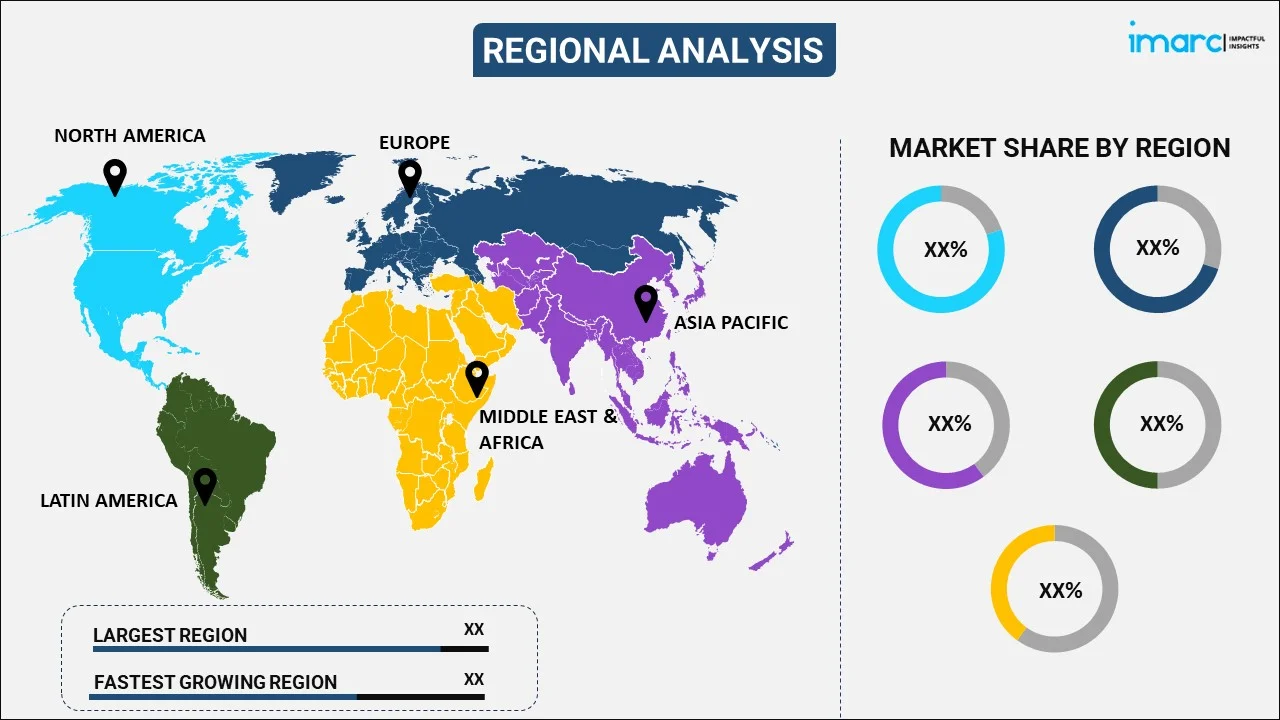
Isobutanol Market Report by Product (Synthetic Isobutanol, Bio-based Isobutanol), Application (Oil and Gas, Solvents and Coatings, Chemical Intermediate, and Others), and Region 2025-2033
Isobutanol Market 2024, Size And Trends
The global isobutanol market size reached USD 1.5 Billion in 2024. Looking forward, IMARC Group expects the market to reach USD 2.4 Billion by 2033, exhibiting a growth rate (CAGR) of 5.27% during 2025-2033. The increased product usage in the pharmaceutical industry, an enhanced focus on regulatory support and compliance, the development and popularity of environmentally friendly solutions, and integration with modern manufacturing processes represent some of the factors that are propelling the market.
|
Report Attribute
|
Key Statistics
|
|---|---|
|
Base Year
|
2024 |
|
Forecast Years
|
2025-2033
|
|
Historical Years
|
2019-2024
|
| Market Size in 2024 | USD 1.5 Billion |
| Market Forecast in 2033 | USD 2.4 Billion |
| Market Growth Rate 2025-2033 | 5.27% |
Isobutanol is a type of alcohol that is predominantly employed in the industrial sector. A four-carbon aliphatic alcohol, it appears as a colorless liquid at room temperature and possesses a mild, agreeable odor. This organic compound has the chemical formula (CH3)2CHCH2OH and is characterized by a unique combination of physical and chemical properties that render it a valuable substance in various applications. It exhibits moderate solubility in water, good solubility in alcohols and ethers, and serves as a solvent for many organic substances. The industrial production of this compound generally involves the catalytic hydration of isobutylene, a process that yields a product widely utilized in manufacturing processes, including the production of coatings, resins, and plasticizers. Its capacity to dissolve, dilute, or disperse various materials.

The global market is primarily driven by the increased demand for this substance in the coatings and adhesives industry. In line with this, the development and popularity of environmentally friendly solutions are also providing an impetus to the market. Moreover, the growing need for this compound in the automotive sector, particularly for automotive applications such as fuel additives, is acting as a significant growth-inducing factor for the market. In addition to this, the versatility and adaptability of this chemical compound to various industrial processes are resulting in its broader application across sectors, thereby influencing the market positively. Some of the other factors contributing to the market include the emphasis on exploring alternative uses in different sectors and the strategic alliances between manufacturers and end-user industries, leading to broader adoption and commercialization.
Isobutanol Market Trends/Drivers:
Increased usage in pharmaceutical industry
The global market is substantially influenced by the expanding application of this compound in the pharmaceutical sector. As a key component in various pharmaceutical products and active pharmaceutical ingredients (APIs), it is an essential element in drug development and manufacturing. With the ever-growing demands in healthcare, especially with the current global focus on public health and innovative medical solutions, it plays a vital role in the synthesis of medications. Alongside this, the surge in research for newer therapeutic drugs and the strict regulations surrounding pharmaceutical formulations require the utilization of high-quality solvents. This has emphasized the importance of the compound in pharmaceutical manufacturing, leading to its increased production and broader application. The alignment with the industry's requirements, coupled with its strategic role in pharmaceuticals, is significantly influencing the global market. Furthermore, the collaborations between pharmaceutical companies and manufacturers of this compound are fostering growth and innovation, solidifying its status as an indispensable part of the industry.
An enhanced focus on regulatory support and compliance
Supportive governmental regulations and policies are crucial drivers of the market, with a particular emphasis on safety, quality, and environmental sustainability. Governments and international regulatory bodies are actively involved in framing guidelines to ensure that industrial operations involving this chemical align with strict quality and safety standards. This regulatory framework not only builds consumer and industry confidence but also motivates manufacturers to invest in technology and adopt practices that adhere to these international norms. Compliance with regulatory standards ensures a supportive environment for growth, fostering trust, and unlocking opportunities across various sectors. The need for transparent and responsible manufacturing, coupled with the global movement towards sustainability, is reinforcing the significance of regulatory compliance. This factor is undoubtedly playing a pivotal role in shaping the market landscape, ensuring that it evolves in line with global expectations and ethical considerations.
Rising integration with modern manufacturing processes
The ongoing integration of this compound with contemporary manufacturing processes across diverse industries stands as a vital factor propelling the global market. Its unique properties, such as solubility and chemical stability, allow it to align seamlessly with modern industrial methodologies. This includes its use in the production of coatings, resins, plasticizers, and various other industrial applications. The alignment with today's production requirements is driving innovation, efficiency, and consistency in the manufacturing sectors, thereby significantly influencing market growth. Collaborative research efforts to explore new applications and enhance existing processes are paving the way for further expansion. Additionally, industry leaders' efforts to optimize manufacturing processes by leveraging this compound's characteristics are adding substantial value to the market. The strategic alignment of this chemical with modern manufacturing principles, coupled with the relentless pursuit of excellence in industrial practices, is providing a robust foundation for the global market's continuous growth.
Isobutanol Industry Segmentation:
IMARC Group provides an analysis of the key trends in each segment of the global isobutanol market report, along with forecasts at the global, regional, and country levels from 2025-2033. Our report has categorized the market based on product and application.
Breakup by Product:

- Synthetic Isobutanol
- Bio-based Isobutanol
Synthetic isobutanol represents the largest market segment
The report has provided a detailed breakup and analysis of the market based on the product. This includes synthetic isobutanol, and bio-based isobutanol. According to the report, synthetic isobutanol represented the largest segment.
The synthetic isobutanol market is witnessing robust growth due to several key factors. The escalating demand for synthetic chemicals in various industries, coupled with advancements in chemical engineering and innovative synthesis methods, drives this growth. The easy availability of raw materials, the versatility of synthetic isobutanol across applications like solvents, coatings, and fuel additives, and growing requirements in both industrial and consumer products, further contribute to the market's expansion.
On the other hand, the bio-based isobutanol segment is thriving, spurred by current societal trends. These encompass a rising awareness of environmental issues, strict governmental regulations favoring green chemicals, a surge in consumer inclination towards sustainable products, cutting-edge technological evolution in bio-processing, and an expanding application of bio-based isobutanol in the domains of biofuels and renewable resources.
Breakup by Application:
- Oil and Gas
- Solvents and Coatings
- Chemical Intermediate
- Others
Chemical intermediate accounts for the majority of the market share
The report has provided a detailed breakup and analysis of the market based on the application. This includes oil and gas, solvents and coatings, chemical intermediate, and others. According to the report, chemical intermediate represented the largest segment.
The chemical intermediate segment of the isobutanol market is being propelled by rising demand in pharmaceuticals, growing industrial applications, increased investment in research and development, diversification in end-use industries, and the requirement of specialty chemicals in various production processes.
On the other hand, growth in the solvents and coatings segment is attributed to the booming construction industry, rising automotive production, increased focus on environment-friendly products, growth in industrial manufacturing, and the versatile nature of isobutanol in producing high-quality paints, lacquers, and varnishes.
Also, the oil and gas segment of the market is driven by increasing global energy demand, advancements in drilling and extraction technologies, growth in offshore exploration activities, expansion of refineries, and rising demand for cleaner-burning fuel alternatives. Isobutanol's application in fuel blending contributes to efficiency and performance.
Furthermore, the others segment is fueled by the adoption of isobutanol in niche applications such as cosmetics, adhesives, household products, and an increasing need for customized solutions in various smaller-scale industries, such as the production of plasticizers and lubricants.
Breakup by Region:

- North America
- United States
- Canada
- Europe
- Germany
- France
- United Kingdom
- Italy
- Spain
- Others
- Asia Pacific
- China
- Japan
- India
- South Korea
- Australia
- Indonesia
- Others
- Latin America
- Brazil
- Mexico
- Others
- Middle East and Africa
Asia Pacific exhibits a clear dominance, accounting for the largest isobutanol market share
The report has also provided a comprehensive analysis of all the major regional markets, which include North America (the United States and Canada); Europe (Germany, France, the United Kingdom, Italy, Spain, and others); Asia Pacific (China, Japan, India, South Korea, Australia, Indonesia, and others); Latin America (Brazil, Mexico, and others); and the Middle East and Africa. According to the report, Asia Pacific accounted for the largest market share.
In the Asia Pacific region, the market is experiencing significant growth, fueled by a combination of industry-specific and regional factors. The presence of established industries such as pharmaceuticals, automotive, and chemicals; advancements in technology; robust research and development; stringent environmental regulations; and a strong focus on sustainability all drive the market.
Additionally, the region's well-established infrastructure, growing shale gas exploration, commitment to reducing carbon emissions, increasing trade activities, an affluent consumer base, focus on innovation, and presence of key market players collectively contribute to the expansion of the market.
The government's support for environmentally friendly practices, alignment with global sustainability goals, strategic investments in research, the presence of leading academic institutions, and consumer awareness regarding green products further reinforce the leading position of the region in the market.
Competitive Landscape:
The key players in the market are implementing a series of strategic initiatives to ensure market growth. These include investing heavily in research and development to innovate new products and applications, improving existing synthesis processes, and expanding production capacities to meet growing demand. Many are forming strategic alliances, partnerships, and collaborations with other industry participants to leverage complementary strengths and penetrate new markets. A strong focus on sustainability is also evident, with companies increasingly exploring and investing in bio-based isobutanol to align with global environmental regulations and consumer preferences for green products. Additionally, key players are engaging in aggressive marketing and sales strategies, expanding their geographical reach, and adopting digital and technological advancements to enhance operational efficiencies and customer reach. These combined efforts are positioning the key players to capitalize on the emerging opportunities in the isobutanol market and drive continuous growth.
The report has provided a comprehensive analysis of the competitive landscape in the market. Detailed profiles of all major companies have also been provided. Some of the key players in the market include:
- BASF SE
- Eastman Chemical Company
- Gevo
- Grupa Azoty S.A.
- INEOS Group Limited
- Mitsubishi Chemical Corporation (Mitsubishi Chemical Group Corporation)
- Nan Ya Plastics Corporation
- OQ Chemicals GmbH
- Petronas Chemicals Group Berhad
- Sasol Limited
- The Andhra Petrochemicals Limited
- The Dow Chemical Company
Isobutanol Market Report Scope:
| Report Features | Details |
|---|---|
| Base Year of the Analysis | 2024 |
| Historical Period | 2019-2024 |
| Forecast Period | 2025-2033 |
| Units | Billion USD |
| Scope of the Report | Exploration of Historical and Forecast Trends, Industry Catalysts and Challenges, Segment-Wise Historical and Predictive Market Assessment:
|
| Products Covered | Synthetic Isobutanol, Bio-based Isobutanol |
| Applications Covered | Oil and Gas, Solvents and Coatings, Chemical Intermediate, Others |
| Regions Covered | Asia Pacific, Europe, North America, Latin America, Middle East and Africa |
| Countries Covered | United States, Canada, Germany, France, United Kingdom, Italy, Spain, China, Japan, India, South Korea, Australia, Indonesia, Brazil, Mexico |
| Companies Covered | BASF SE, Eastman Chemical Company, Gevo, Grupa Azoty S.A., INEOS Group Limited, Mitsubishi Chemical Corporation (Mitsubishi Chemical Group Corporation), Nan Ya Plastics Corporation, OQ Chemicals GmbH, Petronas Chemicals Group Berhad, Sasol Limited, The Andhra Petrochemicals Limited, The Dow Chemical Company, etc. |
| Customization Scope | 10% Free Customization |
| Post-Sale Analyst Support | 10-12 Weeks |
| Delivery Format | PDF and Excel through Email (We can also provide the editable version of the report in PPT/Word format on special request) |
Key Questions Answered in This Report:
- How has the global isobutanol market performed so far, and how will it perform in the coming years?
- What are the drivers, restraints, and opportunities in the global isobutanol market?
- What is the impact of each driver, restraint, and opportunity on the global isobutanol market?
- What are the key regional markets?
- Which countries represent the most attractive isobutanol market?
- What is the breakup of the market based on the product?
- Which is the most attractive product in the isobutanol market?
- What is the breakup of the market based on the application?
- Which is the most attractive application in the isobutanol market?
- What is the competitive structure of the global isobutanol market?
- Who are the key players/companies in the global isobutanol market?
Key Benefits for Stakeholders:
- IMARC’s report offers a comprehensive quantitative analysis of various market segments, historical and current market trends, market forecasts, and dynamics of the isobutanol market from 2019-2033.
- The research study provides the latest information on the market drivers, challenges, and opportunities in the global isobutanol market.
- The study maps the leading, as well as the fastest-growing, regional markets. It further enables stakeholders to identify the key country-level markets within each region.
- Porter's five forces analysis assist stakeholders in assessing the impact of new entrants, competitive rivalry, supplier power, buyer power, and the threat of substitution. It helps stakeholders to analyze the level of competition within the isobutanol industry and its attractiveness.
- Competitive landscape allows stakeholders to understand their competitive environment and provides an insight into the current positions of key players in the market.
Need more help?
- Speak to our experienced analysts for insights on the current market scenarios.
- Include additional segments and countries to customize the report as per your requirement.
- Gain an unparalleled competitive advantage in your domain by understanding how to utilize the report and positively impacting your operations and revenue.
- For further assistance, please connect with our analysts.

 Inquire Before Buying
Inquire Before Buying
 Speak to an Analyst
Speak to an Analyst
 Request Brochure
Request Brochure
 Request Customization
Request Customization



.webp)




.webp)












